Learning how to use mother nature’s resources is a necessary skill during survival situations. Centuries before us, our ancestors scaled the forests and woodlands, learning the ins and outs of the wilderness, most of which can be easily overlooked by the modern-day outdoor enthusiast.
However, if ever found in a fight or flight circumstance, we are surrounded by life-saving earthly materials, one of which is the mighty pine tree.
Where To Find Pine Trees
Native to the Northern Hemisphere, pines prefer cooler climates and are popularly found among forests in Northern America, China, South-East Asia, Russia, and Europe. Although they prefer cooler climates, pines are a sun-loving tree that grows best in sandy, well-draining soil that is on the more acidic and calcareous side.
With nearly 100 different species inhabiting the earth, you are likely to come across pine-ridden woodlands during your wilderness adventures.
Survival Pine Trees
Pine trees are a rather bountiful source of sustenance and essential nutrients. Containing rich amounts of fiber and vitamin C, most parts of the tree can bring your body nourishment and fend off the aches of impending starvation. Using pine trees as a major food source began with the native tribes in the Great Basin Area of the United States and parts of Mexico.
Pine trees, specifically the pine nut, was used as sustenance during long tredges of travel and animal hunting expeditions that could carry on for several weeks at a time.
Most parts of the pine tree are edible, except for the outer bark. The pine needles can be dried and used in boiling water as a pine needle tea to help warm up the body and boost your immune system on a cold night. The pinecones are a source of seeds (if female), and a source of pollen (if male), and are quite tasty when boiled.
One of the most popular ways to eat pine is by harvesting the inner bark, which can be eaten raw, dried, or muddled into flour.
How To Harves Pine Bark
Many people are not aware that while walking through the forest they are surrounded by an astonishing survival edible, the pine tree! When harvested, prepared, and stored properly, it is a rather flavorful food source, and harvesting the bark is a fairly simple process.
Related: 25 Little Known Survival Uses For Tree Bark
1. First, identify a pine tree. With pines being the most common coniferous tree worldwide, it is likely you will encounter a pine tree while trekking through the forest. Different species of pines will give you slightly different tastes in the bark. It is said white pine is widely considered the best tasting pine species, but other species come in close comparison, including Red Spruce, Black Spruce, Balsam Fir, Tamarack, Yellow Birch, Black Birch, Slippery Elm, and more.
Sidenote: Although most pines are perfectly edible, be weary of the poisonous species. These include the Norfolk Island pine, the Yew pine, and the Ponderosa pine. While Norfolk Island pines are typically localized near the South Pacific Ocean from New Caledonia to New Zealand, and Yew pines grow in China and Japan, Ponderosa pines are more widespread, growing anywhere between southern Canada to New Mexico, and from Nebraska and Oklahoma spanning all the way to the Pacific Coast.
2. Choose a pine tree that is more mature, pines can live up to 100-200 years! Find one with a larger trunk, or at least larger than the width of your wrist.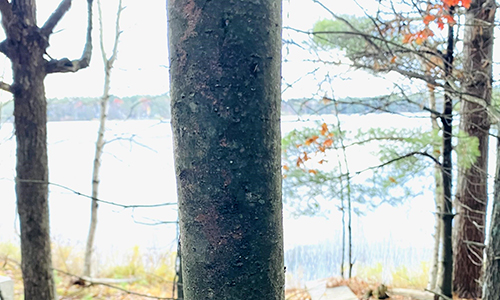
3. Take a large knife and begin scraping off the outer bark. The outer bark is NOT edible and therefore is not useful for food preparation purposes.
Related: How To Use The Bark Of This Common Tree To Keep Your Meat From Spoiling
Continue to scrape the outer bark off until you reach the next layer of the tree called the phloem. The phloem is typically lighter in color than the outer bark, but darker in color than the cambium (or inner bark).
Sidenote: Do not scrape off a section larger than 1/10th the circumference of the tree. The phloem is the life source of the tree, this is where sap runs up and down the tree, giving it nourishment. If scraped off in small sections, the phloem is capable of healing itself so the tree can continue to grow and prosper.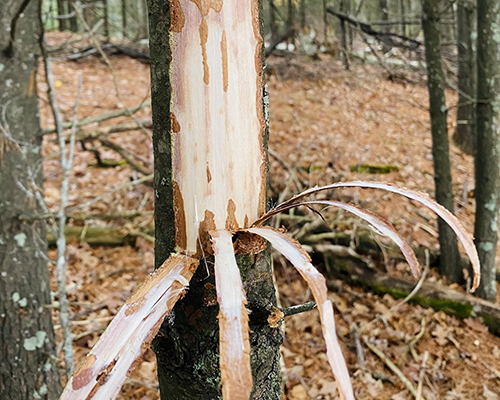
4. Once the phloem is removed and the inner-bark, or cambium, is exposed, begin harvesting by driving the tip of your knife into the bark, and then scoring a vertical line downwards. Do this again an inch or two away from the first score. Next, connect the two lines at top and bottom to make a vertical rectangle.
5. Pry the rectangular strip away from the tree peeling the inner-bark from the top horizontal score, down to the bottom horizontal score.
Sidenote: This process is typically easier to do during the spring when the tree is moister with sap. The bark tends to be drier in the autumn and may not strip off in one clean sheet.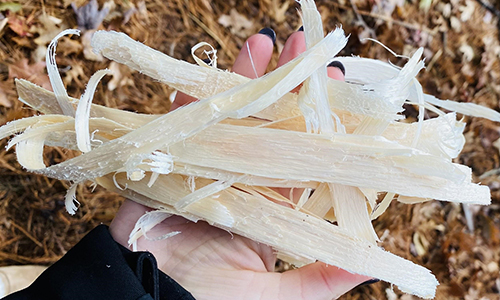
You can use your knife to scrape off any remaining tender white inner-bark and repeat the process until you feel you have harvested enough bark for your needs. One of the easiest ways to transform your pine bark into an easily packable and travel-friendly food source is by making it into flour.
Once in flour form, it can be eaten as is, or used to coat meats and foods for deep-frying, and even baked into bread. Below, is a simple pine bark bread recipe.
Related: 6 Backyard Plants You Can Turn Into Bread
Preparing Pine Bark Bread
STEP ONE: Dry out your bark. Heat your oven to 170 degrees F. Lay your bark out into a baking sheet and bake for about 1 hour or until crisp, checking on them every 10-20 minutes during the drying process.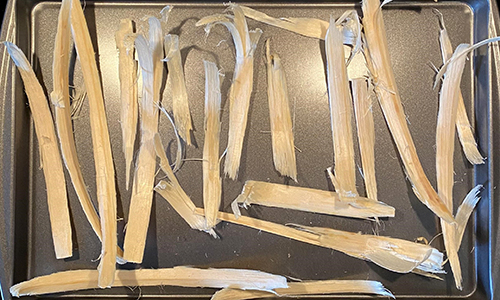 You can do this over a small fire as well (this will give your bark a smokey smell and taste).
You can do this over a small fire as well (this will give your bark a smokey smell and taste).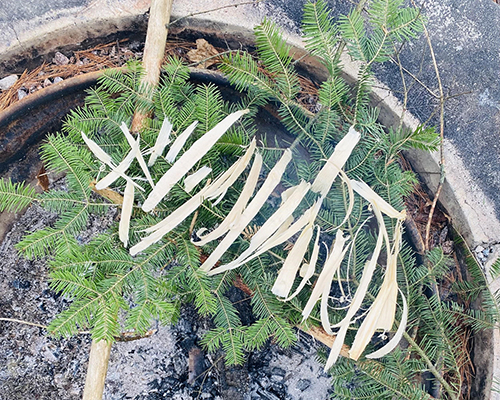 If you prefer to do it the way our ancestors did, a third option is to dry out your bark in the sun for up to 3 days, or until it turns a tanned color.
If you prefer to do it the way our ancestors did, a third option is to dry out your bark in the sun for up to 3 days, or until it turns a tanned color.
STEP TWO: Once your bark is fully dry, it is ready to be made into a powder, or bark flour. You can use a blender or food processor. Break up your dried bark strips into small pieces before adding them to your blender so it is less work on the motor.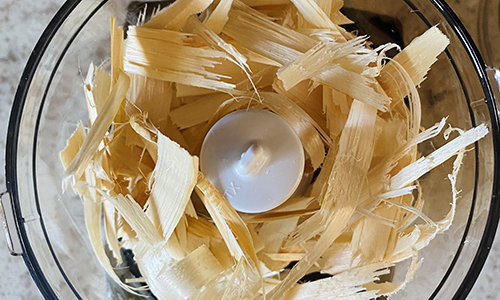 Pulse the dried bark until it has reached powder form. It most likely will have a coarser texture to it. Be aware if you run your blender or food processor for too long, the motor may begin to overheat.
Pulse the dried bark until it has reached powder form. It most likely will have a coarser texture to it. Be aware if you run your blender or food processor for too long, the motor may begin to overheat.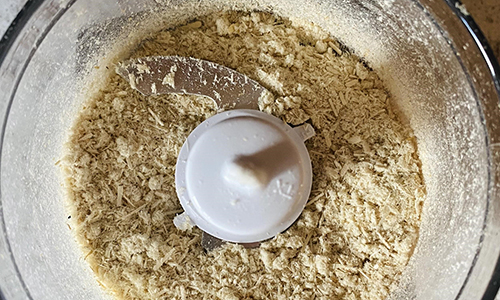 You can also use a muddler or a hammer to crush it into flour.
You can also use a muddler or a hammer to crush it into flour.
STEP THREE: Once your bark is in a powder form, it is time to prepare the bread dough. Some tips for preparing your bread dough include:
a. Follow a 40% bark flour to 60% other flour ratio. Do not use more than 40% bark flour in your bread recipe.
b. Add 50% water (or other fluid) to the total amount of flour used. So if you use 2 cups of bark flour and whole wheat flour combined, you would use 1 cup of water.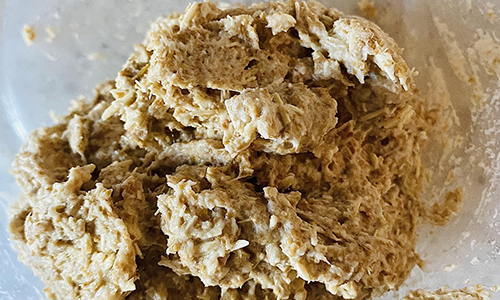
Here is a simple recipe to follow:
- ¾ cup pine bark flour
- 1 ¼ cup whole wheat flour
- 1 cup cold water
- one tsp salt
Baking Instructions:
1. Heat oven to 350 degrees F.
2. Add the flour, water, and salt into a large bowl and combine until a dough forms.
3. You can keep the shape of one large dough ball, or separate and shape the dough into 6 dinner rolls.
4. Bake for 35 to 45 minutes, or until the outside is crispy and the inside is no longer moist and doughy.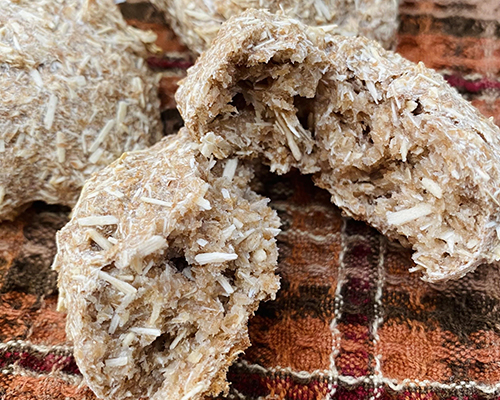 Tip: This is a very basic pine bark bread recipe that you can easily add your own twist on.
Tip: This is a very basic pine bark bread recipe that you can easily add your own twist on.
Related: How To Collect Pine Pollen – A Long Lasting Super Food
Some suggestions are adding a sweetener or herbs and spices to the dough before baking, like:
- 1 Tbsp honey or maple syrup
- ½ to 1 tsp of spices or herbs (cinnamon, rosemary, nutmeg, cloves, garlic)
5. Store bread in a cool, dark area.
Other Survival Benefits Of Pine Trees
Pine trees are a truly mystical natural resource, and aside from its superfood nourishing benefits, pines can be used as a very versatile survival tool:
Medicine: Being a natural antiseptic with antibacterial and antifungul properties, pine resin can be apply directly to wounds to encourage the healing process. It is commonly used to aide in the removal of splinters stuck in the skin. Just simply apply the resin to the affected area, and the splinter should come out on its own within 1 to 2 days.
Fire Starter: The resin can also be used as a natural fire starter, and is extremely flammable even when branches are slightly damp.
Shelter: Resin can be used as a building tool when combined with a small amount of charcoal from an existing (and extinguished) fire to form a glue for constructing shelters. Also the bristly boughs of pine trees are useful in making walls for shelter, or cushioning for a warm, dry bed.
So if you find yourself in a sticky situation, lost or stranded in the wilderness, and your stomach starts rumbling, seek out a pine tree. It is one of the most plentiful natural resources and may very well be what saves your life.
You may also like:
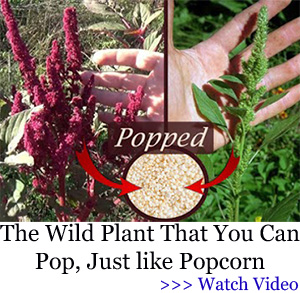 Meal In A Bag: Sweet And Spicy Meat And Rice
Meal In A Bag: Sweet And Spicy Meat And Rice
How To Make Bark Bread From A Tree That Grows On Almost Every Street in America (Video)















What other kinds of tree bark can be used?
Yes! Birch, elm, spruce, and balsam fir are also commonly used to make tree bark flour!
Nice thread on this… Has the author personally had this Pine park bread ?
Would be interesting to try it.
I haven’t made a pine tree bread but I have made myself tea from the Douglas Firs in my back yard. I took a few of the young light green tips and steeped them in hot water for a few minutes. I didn’t steep them very long because the advice I got was that longer steeping releases more of the turpentine flavor but some say the “turpentine” is good for us. I added a bit of honey. Nothing to write home about as far as flavor goes but very healthy. The spring growth is supposed to be more citrusy in flavor.
Next spring I will pick some new light green shoots from around the lower edges and freeze them for use later.
Yes, the pictures in the article are from my personal experience using pine bark flour to make biscuits! I was surprised by the final product, I enjoyed the flavor, as did my family. Pine bark flour adds a warm flavor to the biscuits. It’s mildly woody, but not overwhelmingly so!
We live in and around loblolly pine forests in east Texas at the southern edge of Davy Crockett National Forest. I’ve never tried pine bark but pine knots (fat wood) is great for getting a fire going quickly.
Norfolks are abundant here. Idiots keep planting them as ornamentals. They’re even more useless than I thought. As are the Norfolks.
Norfolk pine is planted fairly widely in SoCal. That said, once you have a Norfolk pine pointed out, they will be easy to recognize thereafter. Their needle and growth pattern is so easy to recognize even I can tell a Norfolk pine in a glance.
Yew or podocarpus is also widely planted in SoCal. I have several podocarpus growing in my yard that I planted. Again, once pointed out and identified, you should have no trouble identifying them. Like me, you might be surprised that they are in the line family.
Ponderosa pine, on the other hand is more difficult for me to identify. They are also called yellow pine and bull pine among other names. For me identifying a ponderosa pine is very difficult. I know that the bark is supposed to be distinctive but standing by itself or in a group of pine trees to me the barks are all so similar I cannot differentiate.
I apparently didn’t pay close enough attention in Tree Identification for Boneheads 101.
The Ponderosa Pine is supposed to have an orange under coloration to the bark and a scent like butterscotch. I haven’t tested this out myself.
That is interesting regarding the Yew family.
The squirrels eat the new pine cones off my tree, they eat them like an ear of corn then throw the core at my dog . I tried them a couple times , not bad at all but probably not eat too many at once.
They do that around here, too. Kinda funny, IMO. My dog doesn’t think so.
Small correction – Yellow and Black Birch, and Slippery Elm are edible, but are not pine trees. This makes them harder to identify in the winter (without leaves), but they are most useful in the Spring when they should be starting to leaf out.
When harvesting bark from trees, for survival or especially for experimentation, make sure you aren’t disfiguring and quite possibly injuring trees that are on private property (that is not your own), and may be defended with gunshots or possible arrests. In an eventual SHTF situation, this will probably be a moot point, but be respectful of personal private property in any case.
One more possible question for the author – I was confused about the Ponderosa Pine being considered a toxic species, and found a handful of articles and studies about the western Native Americans regularly peeling Ponderosa Pine bark for food in lean seasons. Does the author have a source for the Ponderosa’s toxicity? I don’t mean to be argumentative, but it would be a shame to ignore a food source that actually could be useful…?
I have heard the same thing but have no source to confirm that the ponderosa is toxic. I don’t think it is so toxic as to kill one, unless eating massive quantities. Remember that line from SNL?
I think it is toxic enough to perhaps wish one would die, but no such luck, just suck it up and resolve not to make that mistake again.
It may be that ponderosa is like acorns it needs extra processing. That is pure speculation on my part. I promise to go on line and research the topic and report my findings here, just not this morning as I am doing wash today. You know the old Monday is wash day?
LCC,
Isn’t today Tuesday? ?
Whatever day it’s, have a great day, sir.
Peace,
MadFab
Madfab: The PDRK is out of step with the rest of the country on so many other things, why do you find it hard to believe that they are out of step with days of the week??
H. Himmler: “Tell a big enough lie often enough and people will believe it.”
Hope your M.i.L. Was able to get her injuries treated satisfactorily. Broken kneecap sounds serious to me because of potential damage to the underlying structures. Have one bionic knee and one OEM knee with lots of mileage on it, I can commiserate with her about the debilitating effects of damaged knees.
Look at this Cindy,
https://journals.sagepub.com/doi/pdf/10.1177/030098589603300103
Greets from the Netherlands
Tigron
Thank you Tigron! I had read a little further in my articles, and had seen that it was the needles that were the toxic issue. Mainly, it was the abortifactant action in cows that was studied, but there was also anecdotal information about the same in people. This would be a problem with those who like to, or want to, drink pine needle tea for the Vitamin C and health benefits. Makes being able to identify species pretty crucial…
Greetings from Indiana!!
That’s a good article you linked to. You can prepare tea safely from Ponderosa and Loblolly pine needles by not using boiling water, water heated to just below simmering will not dissolve the terpenes in the needles but will make the vitamin C available. Here’s another good Ponderosa Pine link: http://www.naturalmedicinalherbs.net/herbs/p/pinus-ponderosa=ponderosa-pine.php
and here is a good link on Loblolly Pine, there are 4 Southern Pines and Lob is the most useful: https://www.foragingtexas.com/2006/04/loblolly-pine.html
Pines are important in foraging because they are so common, I’d still rather set up a blind near a stand of Pinyon Pine and shoot a bear eating the pine nuts instead of me living off pine nuts. Best way to get energy from plants is to kill the animals that eat them. Except for squirrel, yuck, don’t like the bushy tail rat.
People who have cattle have found that when pregnant cows eat the grass growing underneath Ponderosa Pine trees, they lose their calves and don’t carry them to term. When it rains and the pine needles get washed off, it drips onto the grass below.
Interesting but I wonder if this is a really edible flour or just a belly filling Extender of flour?
I am aware Indians (Native Americans PC, eh?) used various grass seeds ground into flour to make pan breads and used bark flour also.
A lot of odd emergency foods were more for bulk than anything else. Like chopped up grass and leftovers stew in the Bosnia ethnic cleansing, not generally enjoyable but your belly needs food.
For all the work maybe, you should look at planting potatoes and using them for food and an Edible and nutritious Bread Flour extender. Potato Bread anybody?
Does everyone have fertilizer for the next 2 planting seasons? Another fire at fertilizer plant in US.
Today would be a good day to get some.
Stay safe everyone who is experiencing the ice and snow storms.
Peace
MadFab
Thanks, MadFab, is that a OH comment perhaps?
Lots of interesting (as in Chinese CURSE) “happenings”.
Would you like some ideas about your compost issues?
Hey Michael
No not an OH warming. Just saw it in the news and passing it on.
I would love help with anything in the garden. I have such a black thumb!! Any plant that is my garden needs to be one tough mother, or I will kill it sure as Carters has pills( how’s that for dating myself, lol)
I am in northwest WA, about 60 miles from Canadian border. Says zone 8b. Not close enough to water to have issues with salt. Soil is Very wet clay, so I use raised beds. Also helps on the back as I have fusion from L3 thru S1.
I cannot seem to get/keep compost hot enough and it just ends up stinky slime.
I did see you asked for chicken lentil curry soup. I will get that to ya next week. Headed to Oregon in am. MiL fell and broke Kneecap and her front teeth. Has Ortho apot Friday am and Oral surgeon on Monday.
Leaving Hubby and grandboys home alone. I will either come home to find him in a chair mumbling to himself like Goldie Hawn in Overboard, or him believing I am a Saint, lol. Either way it should be an eye opener, for all of us. He will be ok. He has had them alone,before, but with Lots of help.
Thanks again for the help you or anyone could suggest.
Stay warm and safe.
Peace,
MadFab
Not the kind of fert you should put on a garden, NH4NO3 is good for home brewing explosives and for cooking Meth, not so much for a garden planted in living soil.
A few months ago, I read articles that China was not shipping any fertilizer to the U.S. and Russia wasn’t shipping any to Europe. It had something to do with the lack of ammonia as they need natural gas to produce it. Last year, there were at least a couple of train derailments of fertilizer shipments here in the U.S.
In order to cut back on their prolific and horrible pollution, China cut back on production in some industries because of the Olympics.
The good thing is that there is a shortage of Round-up (glyphosate) too.
I wonder how much fiber is in this recipe 😉
Greetings to Cindy. I’m in Indiana also 🙂
? ?
..those “biscuits” look a little splintery, and not too “crispy”…lol
I’m sure pine bark flour can be a good “extender” for our existing supplies – creativity, leavening, seasonings and some cooking knowledge can go a long way to keep people fed.
See “Dowsing for Edibles” on YouTube
That’s interesting. I will have to try it and see if it works for me.
…So if you find yourself in a sticky situation, lost or stranded in the wilderness, and your stomach starts rumbling, seek out a pine tree…
LOL
Forgive me but I found this paragraph funny after reading how to dry the bark in the oven then powder it in a blender!
…exactly…?
Thank you for your feedback! As pictured in the article, you can dry the bark out over a fire. For true survivalist preparation without access to electrical appliances, the article also mentions you can sun-dry the bark over 2-3 days or until it tans, and then you can use a hammer to crush the dried bark into a powder. Hope this helps!
I promised that I would research ponderosa pine and I did. There is actually quite a bit of information on poisonous greenery.
For starters I went to https://pubmed.ncbi.nlm.nif.gov/8826003
Every site I visited was emphatic that one should leave Norfolk pine and podocarpus macrophyllis strictly alone. Bad news for man and beast including household beasties.
So let’s move on. Somebody at NIH actually fed cows different parts of ponderosa pine. Pine needles caused abortion in cows. Not only did the needles and tips cause abortions, they were toxic and caused a big variety of nasty pathologies in the poor beasties.
Hunker.com
Didn’t have any explanation how they acquired their information, so you can decide for yourselves how much weight to give it’s information. This site agreed that ponderosa pine was generally bad news for man and beast. They also stated that at least 20 familiar pine trees are toxic. They only named three however: ponderosa, lodgepole pine and Monterey pine.
This site mentioned that N.A.s brewed pine needles for teas including ponderosa for respiratory problems and “skin conditions” but didn’t bother to describe what “skin conditions” were so treated. Vague information like that is best disregarded without much more definitive information.
They did list references. This is going to be painful on the iPhone.
USDA Agricultural Research Services: Ponderosa Pine
ASPCA: Yew Pine. Who knew the ASPCA was into botany?
Colorado State University Guide to Poisonous Plants: Ponderosa Pine Er al. This would be a good place for further research. The cover a wide variety of topics including fermenting pine. Retsina anyone? I always thought it tasted like turpentine
Missouri Botanical Garden: podocarpus macrophyllus
USDA: ars.usda.gov. Besides lodgepole and Monterey cypress, this site lists the common juniper as toxic. Now I happen to know that juniper berries are used to season pork in certain Germanic dishes and also is used on gin this site needs further investigation.
https://www.growforagecookferment.com/foraging-for-pine-needles. This is another site that I did not explore but from the url it looks interesting.
Gardenguides.com: pine needles are believed to cure scurvy. Some eastern countries pickle pine needles.
Kind of sparse research but I wasn’t try to writ my doctoral thesis on pine needles and their possible toxicity to man and beast. One source, Hunker.com suggested that although the N.A.s might have used pine needles their might have been subsequent miscarriages or low birth weight and other unnamed toxic reactions. They recommended not consuming pine needles.
Based on what I gleaned from very brief research into the subject, I would be wary about consuming pine needles. I absolutely would not consume them if I were a woman of childbearing age.
I think if you are going to explore what is suggested in the article and start peeling pine trees you owe it to your family and others depending upon your prepper advice to do a lot more research on the topic of consuming pine tree products.
Some older folks — older than I which is really, really ancient — used to consume turpentine as a curative for some ailments. Until the 20th century doctors used to treat syphilis with mercury too. The current thought is that syphilis did not cause deterioration of brain function as was long thought, it was the mercury medical treatment that caused the insanity associated with long term syphilis. “Doc, you’re driving me crazy.”
Of course turpentine is a product of pine sap distillation for lack of a more accurate description. I don’t know how much was drunk at a time and what the length of such treatment was and I don’t know for what ailments it was or still is for that matter. As I write this I remember after I bought a gallon of turpentine from Amazon because I could only find pint quantities in stores in CA, I got a customer question about whether it was potable turpentine, so at least one Amazon customer is still drinking the stuff. He is made of sterner stuff than I.
It’s late and my eyeballs are whirling in their sockets from reading on the tiny iPhone screen. I am not going to attempt to proof read this, so if there are a lot of typos, rag on Claude to fix his damned damned website I can once again sccess this site on my MAC computer
Toxic Pines:
English Yew (little red “berries”)
Norfolk Island Pine
Yew Pine
Pondersosa Pine (needles contain isocupressic acid)
Lodgepole Pine (needles contain isocupressic acid)
Pencil Cedar
Cypress
Norway Pine
Loblolly Pine
Jeffrey Pine (needles contain isocupressic acid)
The good (non-toxic) Pine trees contain Suramin in the needles. It is said to inhibit the blood coagulation problems created by both the Covid and the vaxx. The needles from the non-toxic trees also contain shikimic acid, which also helps with the effects of the Covid. Shikimic acid is in Tamiflu.
This is a list of non-toxic pines I found when looking for trees that have shikimic acid.
Lodgepole Pine (sap is good for insect bites, etc.)
Western Hemlock (bread and soup thickener)
Western Larch (sap for cuts and bruises)
Western White Pine (roasted young cones for food)
Douglas Fir (soak shoots in water for a mouthwash)
Western Redcedar (antimicrobial)
Grand Fir (resin diluted for an eyewash)
Balsam Fir (higher level of vitamin C)
Black Spruce (young twigs for beer)
Blue Spruce (immature female cones roasted for a sweet)
Incense Cedar (settle an upset stomach)
Cedar of Lebanon (antiseptic and expectorant)
Southern Red Cedar (berries chewed for mouth sores)
Eastern Hemlock (high vitamin C)
Eastern White Pine (bark has more vitamin C than the needles)
I collected this list because I was looking for trees that would be good to make a healthy tea with and get some shikimic acid.
Thank you Lin, for the new thread to dig into!
Thanks, Lin, for such good information. Now if I could just learn to distinguish loblolly pine from lodgepole pine I would be in good shape.
Left Coast Chuck.
I understand that completely! Some trees take on a different appearance because of growing conditions plus the season. Several of my Douglas Fir trees started out as those little $2 trees that are sometimes for sale at the check-out counter on Arbor Day. Each one looks a bit different today..
Actually, Judge that is still a common fertilizer and or a pre-curser to the ones you see in any Ag supply store.
Urea is more commonly used by tweekers.
Yeah, in Texas the tweekers actually steal the1000g pressure tanks of pure Ammonia farmers use for nitrogen injection, not the ammo nitrate. I was working on a farm when McVeigh blew up the Murrah Building, we had a barn full of Ammo Nitrate in the same blue plastic barrels he used, very strange and sad. Ammonia Nitrate fertilizers are so widely overused in Agriculture and residential landscape that the rivers, lakes, and oceans are quietly being transformed into dead zones.
Anyone heard from Ref Ant? Hope he is doing OK.
Peace
MadFab
@ MadFab
I’m still here, just been staying on the low. Keeping GRAY…
Been watching and reading and studying lots of stuff. Getting ready!!!!!!!
Thank you for remembering me. Very kind of you to notice. Again Thank you…
Been getting things ready for the “crap show” coming this year. Putting my ducks in a row.
Making a massive list to buy before spring time. Last time I will be buying anything other then just the basics.
Hope all y’all have gotin all the stuff you will need to get down the road just a little farther.
If you live in TEXAS Please vote for Governor Abbott.
We DO NOT need these DAM demacraps screwing up TEXAS, with there communist life style.
That CHINA lover, Beto O’Rourke is going around TEXAS trying to push his communist ways on us and spread lie’s about Greg Abbott. Abbott kept TEXAS alive and OPEN.
Beto O’Rourke wanted to take ALL our GUNS and gun rights form “ALL of US”… Remember… That’s when he tried to run for president in 2020. sorry for the RANT.
Again, Thank you MadFab for you…
Red Ant,
Glad to hear all is as OK as can be in these Crazy times.
Trying to keep our heads as all others around us lose theirs, is difficult to say the least.
Hope the storms for Texas leave you and yours unscathed.
Peace,
MadFab
Nice to hear from you again, red ant. Better to spend your time preparing as much as you can. The time grows short for all of us. As I’ve said before I don’t exactly know how it’s going to go down or when. Could be anything from the sniffles to fill-blown hyperinflation. What many in the know seem to be saying is that a currency devaluation, reset and the transition to a digital currency is inevitable. Just doesn’t happen overnight. At first it’s a long slow fall and then it speeds up. Look to Turkey to see what a collapse looks like. It’s happening right in front of our eyes. Inflation in Turkey close to 50%. The US monetary system is collapsing and the US dollar has run its course. It’s purchasing power is close to nil as are most of the other world fiat currencies. Most of the monetary systems they’ve come up with only last about a century and then they fall apart. It’s a pattern that’s been repeating for thousands of years. Either we don’t learn from history or it keeps being done intentionally to keep the masses in servitude. Most of us on this page shouldn’t be worried or afraid of the future as we are of the prepared mind and should have been stacking for years at this point. Don’t hoard like some of the people panicking right now but just keep preparing as much as you can while prices are still relatively reasonable. We of the prepared mind WILL make it through this. Also not a fan of the far left. Have a good friend like that. Don’t know whether I should take a baseball bat and just put them out of their misery. Feel so bad for the people on the left. They are just so wrong-headed and they don’t even realize it. Don’t know how to get to them. Certainly can’t confide in them. They’d just bring all their friends to my friend door when SHTF happens and expect me to feed them all. Would leave me with some very difficult choices. Maybe we just have to keep loving our friends no matter their political leanings. They just can’t be part of our MAG. Sigh. 🙁
Hello Armin
yes, good to hear from you also.
Hope you are doing good.
been on the low so not saying much.
Thank you for the post and replying back about my rant.
You stay safe up there.
KEEP ON TRUCKING. We need to back the truckers.
Stay strong and praying for every one to be safe.
Lin: I must admit that I have never sniffed a ponderosa pine to see if it smelled like butterscotch. The city where my wife’s day care is located has about a five-mile stretch of roadway lined with ponderosa pines on both sides. I wonder if I will be accosted by law enforcement if I am observed sniffing their trees?
LCC, being on the left coast, law enforcement may consider sniffing the trees “normal” 🙂
Recently I read that one can also use the outer bark to make flour.
Hi JoAnne! Yes, you can use the outer bark as well, however the bulk of a tree’s nutrients are found in the inner bark.
So you’re basically making sawdust bread. H’mm. I know people CAN survive on it. I believe the Russians made it during the last war when there was nothing else left to eat. Lots of fibre. 😉 I think though that I would have to be VERY hungry before trying something like that. I’m prepared enough so that I don’t think it’ll ever come to that. At least I fervently hope so. 🙂
..true, and I agree that it would be the VERY last resort for someone who is truly prepped and knowledgeable. This article may be helpful to some – somewhere, someday…? …but better to research methods and techniques that Native Americans actually used for inner tree bark if you want to get the most from it.
Great feedback! Here is an article that takes a deeper look into how Scandinavians and North American indigenous people used pine bark: https://www.fs.fed.us/rm/pubs_other/rmrs_2009_ostland_l001.pdf
always good information but if I am in survival mode I won’t have a food processor or an oven. I hopefully will have an iron skillet, but most likely won’t have any other flour handy (but a nice note to extend my supplies) How would I prepare the pine flour to fry a biscuit? Could I make one with only pine flour? what are the downsides?
Thanks
In Britain (UK+Ireland) Robin Harford writes about edible and medicinal plants, trees, etc. His mailing list is free even to Americans. He offers “long ago history”, a diagram of tree, shrub, fruiting, etc. and often offers recipes.
Scots Pine is focus for today’s send to me (that I share with you). Oddly to me he mentions that sleeping on a pillow with pine needles is good for lungs. Offers info on how Pre-Med people used Scots Pine needles for lung issues. I would think most pines might do the same.
I found the UK site by searching for EATWEEDS.COMM, ROBIN HARFORD.
I add the info below because it may be important to someone smarter than me about web addresses.
Link:
Robin Harford via m.convertkit.com
11:28 AM (3 hours ago)
to me
from: Robin Harford via m.convertkit.com
to: Mark
date: Dec 2, 2022, 11:28 AM
subject: [Eatweeds] Scots Pine
mailed-by: mail.m.convertkit.com
signed-by: m.convertkit.com
security: Standard encryption (TLS) Learn more
: Important according to Google magic.